Weekly Posts and Insights

The Leadership Growth Lattice for Your Learning and Development Efforts
According to LinkedIn’s 2024 Workplace Learning Report, employees are more likely to stay at a company that invests in their learning and development—a key strategy as 90% of organizations express concern about retention. The Leadership Growth Lattice offers a simple yet holistic approach, blending job training, mentorship, and leadership development to create multiple pathways for professional growth.

The Leader as a Gardener of People: Maturity
The final stage of development, Maturity, represents team members who have high aptitude and attitude, capable of bearing fruit and mentoring others. Leaders should empower these individuals by delegating responsibilities and encouraging them to guide those in earlier stages, like the Adolescent follower. By assessing and strategically supporting each team member's growth, leaders can cultivate a thriving and productive environment where everyone can flourish.

The Leader as a Gardener of People: Disgruntled Stage
The "Disgruntled" stage in a follower’s development mirrors the secondary growth phase of plants, where individuals become experienced but may harbor negative attitudes and exhibit inconsistent behavior. These team members often have high aptitude but are susceptible to negativity, which can impact both their performance and the morale of others. Leaders must address these behaviors through open communication, setting clear expectations, and providing opportunities for growth to help them re-engage positively with the organization.

The Leader as a Gardener of People: Adolescent Stage
The "Adolescent" stage of follower development, akin to the teenage years, is a critical period where initial enthusiasm fades, and individuals start testing boundaries while seeking greater responsibility. Leaders must adopt a coaching approach that balances support and accountability, addressing behaviors that don’t align with organizational values, reinforcing early wins, and consistently adhering to established boundaries and goals. By proactively coaching and maintaining a positive environment, leaders can help their team members navigate this transitional phase and continue their growth into confident, competent contributors.

The Leader as a Gardener of People: Seedlings
The post compares leadership to gardening, focusing on how leaders must nurture "seedlings"—new employees or followers—by providing guidance, support, and the right environment for growth. It emphasizes the importance of adapting leadership styles to meet the developmental needs of these individuals, particularly during their early stages. By understanding the balance between aptitude and attitude, leaders can effectively cultivate and develop their team's potential.

No, You're Not Supposed To Be The Most Dominate Voice In The Room: The Leader as a Facilitator
A top-level community leader excels by facilitating team interactions rather than dominating discussions. Their focus should be on managing the process and relationships within the team, allowing team members to share content and ideas. Like a conductor guiding an orchestra, a leader's role is to support collaboration, ensure balanced participation, and create an environment where everyone feels heard and valued.

How to keep from losing good young leaders at your organization
raditionally, corporations have long talked about the leadership ladder - each rung of the proverbial ladder equaling a new role, title, pay, and/or leadership level. Unfortunately, that’s quite an outdated model and just doesn’t work for the new worker.
When we look at the Leadership Growth Lattice, it functions like the name. Instead of straight up, its sprawls out like a garden lattice. It assists in creating a “holistic” employee with multiple dimensions of growth, service and leadership.
Imagine a lattice and the buckets you may want an employee to think about as they grow within your organization.